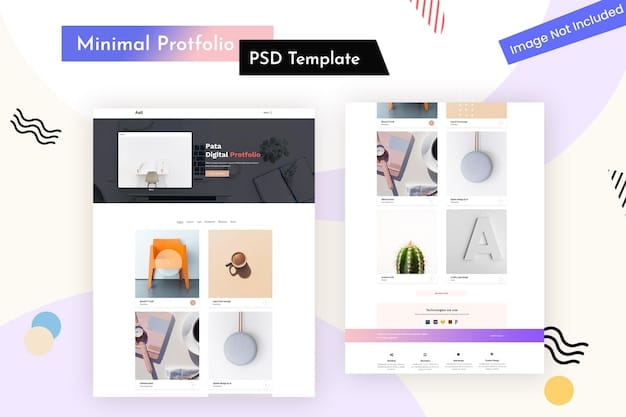E-commerce Website Design: Best Practices for a User-Friendly Experience in 2025

E-commerce Website Design: Best Practices for Creating a User-Friendly Experience in 2025 focuses on intuitive navigation, mobile optimization, secure payment gateways, and personalized content to foster customer trust and increase conversions, ensuring the website adapts to evolving shopper expectations.
Creating a successful e-commerce website in 2025 requires more than just listing products online. It demands a deep understanding of user experience (UX) principles and a commitment to implementing e-commerce website design: best practices for creating a user-friendly experience in 2025. This means focusing on the entire customer journey, from the moment someone lands on your site to the final purchase and beyond.
What specific strategies will drive conversions and build customer loyalty? How can you ensure your e-commerce site stands out in an increasingly competitive digital landscape? Let’s delve into the key elements that will shape the future of e-commerce website design.
Elevating User Experience: Core Principles for E-commerce Design in 2025
In 2025, a superior user experience will be the cornerstone of successful e-commerce platforms. Simplicity, intuitiveness, and responsiveness are no longer optional; they’re fundamental. Understanding cognitive load and employing progressive disclosure are strategies that will help to refine the user interface.
Intuitive Navigation and Site Structure
A clear and logical navigation structure is paramount. Users should effortlessly find what they’re looking for, regardless of their device. Consider utilizing breadcrumbs and predictive search functionalities to improve accessibility.
Mobile Optimization Is Non-Negotiable
With the proliferation of mobile devices, a responsive design is no longer a luxury but a necessity. Ensure your e-commerce site adapts seamlessly to various screen sizes and resolutions, delivering a consistent experience across all platforms.
- Prioritize mobile-first design principles.
- Optimize images and other media for mobile devices to minimize loading times.
- Employ touch-friendly navigation elements for ease of use on touchscreen devices.
In conclusion, focusing on intuitive navigation and mobile optimization is crucial. By prioritizing simplicity, speed, and responsiveness, you can create a user-friendly e-commerce website that caters to the evolving needs of your customers and aligns with e-commerce website design: best practices for creating a user-friendly experience in 2025.
Personalization Strategies for Maximizing Customer Engagement
Personalization has evolved beyond simple name greetings. In 2025, it’s about understanding individual customer preferences and behaviors to deliver tailored experiences. This involves leveraging data analytics to anticipate needs and create personalized product recommendations. Offering targeted promotions and content based on past interactions can significantly enhance customer engagement.

Utilizing Data Analytics for Personalized Recommendations
Harness the power of data to understand customer behavior. Analyze browsing history, purchase patterns, and demographic data to create personalized product recommendations. Implement algorithms that learn from user interactions to refine recommendations over time.
Creating Personalized Content and Promotions
Move beyond generic marketing messages. Segment your audience and create targeted content and promotions based on their specific interests and needs. Use dynamic content to customize website elements, such as product listings and banners, based on individual customer profiles.
Personalization is a key ingredient in creating a user-friendly e-commerce website. By leveraging data analytics and tailoring content to individual preferences, you can increase customer engagement, improve conversion rates, and build brand loyalty, keeping up with e-commerce website design: best practices for creating a user-friendly experience in 2025.
The Role of Visual Design and Branding in E-commerce Success
Visual design and branding are critical components of a successful e-commerce website. A cohesive and visually appealing design can create a strong brand identity, build customer trust, and differentiate you from the competition. Consistency in color palettes, typography, and imagery can enhance brand recognition and foster a sense of professionalism.
Maintaining Brand Consistency Across All Touchpoints
Ensure your brand identity is consistent across all platforms, from your website to social media channels. Use the same logo, color scheme, and typography to create a cohesive brand experience. Adhere to brand guidelines to maintain consistency in tone and messaging.
High-Quality Product Photography and Videography
Invest in high-quality product photography and videography to showcase your products in the best possible light. Use professional-grade equipment and lighting to capture clear and detailed images. Consider incorporating 360-degree product views and videos to provide customers with a comprehensive understanding of your offerings.
- Use consistent lighting and backgrounds for product photos.
- Ensure images are properly optimized for web use to minimize loading times.
- Incorporate videos to demonstrate product features and benefits.
In conclusion, visual design and branding play a crucial role in e-commerce success. By maintaining brand consistency and investing in high-quality imagery, you can create a visually appealing and trustworthy website that resonates with your target audience, aligning with e-commerce website design: best practices for creating a user-friendly experience in 2025.
Streamlining the Checkout Process for Increased Conversions
A streamlined checkout process is vital for maximizing conversions. A complicated or cumbersome checkout experience can lead to cart abandonment and lost sales. Simplifying the process by reducing the number of steps, offering multiple payment options, and providing clear progress indicators can significantly improve conversion rates.
Minimizing Steps and Form Fields
Reduce the number of steps required to complete a purchase. Eliminate unnecessary form fields and streamline the checkout flow. Consider implementing one-page checkout to simplify the process and minimize friction.
Offering Multiple Payment Options
Provide customers with a variety of payment options, including credit cards, PayPal, Apple Pay, and other popular payment methods. This allows customers to choose the option that best suits their preferences and ensures a seamless checkout experience.

A streamlined checkout process is essential for increasing conversions. By minimizing steps, offering multiple payment options, and providing clear progress indicators, you can create a user-friendly checkout experience that encourages customers to complete their purchases and contributes to successful e-commerce website design: best practices for creating a user-friendly experience in 2025.
Prioritizing Website Security and Building Customer Trust
Website security is paramount in building customer trust. In an era of increasing cyber threats, customers are more concerned than ever about the security of their personal and financial information. Implementing robust security measures, such as SSL encryption and PCI compliance, is essential for safeguarding customer data and building confidence.
Implementing SSL Encryption and PCI Compliance
Secure your website with SSL encryption to protect sensitive data during transmission. Comply with PCI DSS standards to ensure the secure handling of credit card information. Display trust badges prominently to reassure customers that their data is safe.
Transparency in Data Collection and Usage
Be transparent about how you collect and use customer data. Provide a clear and concise privacy policy that outlines your data practices. Obtain explicit consent before collecting personal information and allow customers to opt out of data collection if they choose.
Prioritizing website security is essential for building customer trust. By implementing robust security measures and being transparent about data practices, you can create a safe and secure online shopping environment that fosters customer confidence and supports the objectives of e-commerce website design: best practices for creating a user-friendly experience in 2025.
Accessibility Considerations for a Broader Audience
Designing for accessibility ensures that your e-commerce website is usable by people with disabilities. This includes making your website compliant with accessibility standards, such as WCAG, and incorporating features that accommodate users with visual, auditory, motor, and cognitive impairments. Creating an inclusive website not only expands your potential customer base but also demonstrates a commitment to social responsibility.
Adhering to WCAG Guidelines
Follow the Web Content Accessibility Guidelines (WCAG) to ensure your website is accessible to people with disabilities. Use semantic HTML, provide alternative text for images, and ensure sufficient color contrast. Test your website with assistive technologies to identify and address accessibility issues.
Incorporating Features for Users with Disabilities
Integrate features that accommodate users with disabilities, such as screen reader compatibility, keyboard navigation, and adjustable font sizes. Provide transcripts for audio and video content and ensure your website is usable by people with motor impairments.
“`html
| Key Point | Brief Description |
|---|---|
| 📱 Mobile Optimization | Ensures seamless experience on all devices. |
| 🛒 Streamlined Checkout | Reduces cart abandonment and boosts sales. |
| 🔒 Website Security | Builds trust by protecting customer data. |
| 🎨 Visual Branding | Creates a strong and recognizable brand identity. |
“`
Frequently Asked Questions
Key elements include intuitive navigation, mobile optimization, personalization, streamlined checkout, robust security, and accessibility for all users.
Mobile optimization is critical due to the increased use of mobile devices for online shopping. A responsive design is essential for a seamless experience.
Personalization involves tailoring content, product recommendations, and promotions to individual customer preferences, boosting engagement.
Website security is crucial for building customer trust. Implementing measures like SSL encryption protects sensitive data and builds confidence.
Accessibility ensures your website is usable by people with disabilities, expanding your potential customer base and demonstrating social responsibility. This should be kept in mind during the e-commerce website design: best practices for creating a user-friendly experience in 2025 process.
Conclusion
In conclusion, creating a user-friendly e-commerce website in 2025 revolves around understanding and implementing several key principles. From mobile optimization and personalization to streamlined checkout processes and robust security measures, every aspect of the user experience must be carefully considered. By prioritizing these elements, businesses can build successful online platforms that foster customer loyalty and drive conversions.
Ultimately, embracing e-commerce website design: best practices for creating a user-friendly experience in 2025 means investing in strategies that cater to the evolving needs and expectations of online shoppers, ensuring a seamless and engaging experience that sets you apart from the competition.





